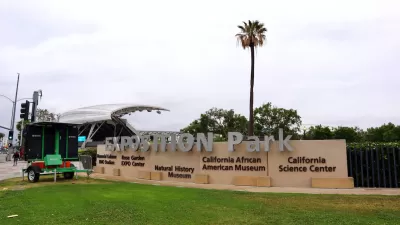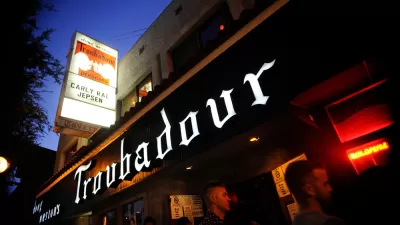In this reflection on the new book "Los Angeles in Maps", James Rojas wonders what shape the city will take in the near and far future.
"The book's historical and archival maps of Los Angeles give a powerful account of the city's growth and development, highlighting how topography, policies, resources and infrastructure systems shaped L.A.. The maps start with the Spanish ranches and L.A.'s early street grid, and move from there to early rail maps that predict the region's development patterns. Small towns surrounded by farms were located along rail lines. Oil wells and movie studios grew around those towns and shaped how we used our resources. All this helped create our messy, vibrant urban sprawl.
Today, it is impossible for any single policy, resource, or system to reshape L.A. the way those early systems did because we are just too massive in scale. We also no longer have plentiful tracts of empty land, nor the capital to build major projects. (Or, maybe we just built the wrong major projects, like massive housing on former orange groves at the urban edge?)."
Rojas argues that while infrastructure largely guided the form of the city throughout its history, ethnic and cultural diversity are playing a bigger role today in reshaping the city.
FULL STORY: Los Angeles in Maps: What's Next?

Alabama: Trump Terminates Settlements for Black Communities Harmed By Raw Sewage
Trump deemed the landmark civil rights agreement “illegal DEI and environmental justice policy.”

Planetizen Federal Action Tracker
A weekly monitor of how Trump’s orders and actions are impacting planners and planning in America.

Why Should We Subsidize Public Transportation?
Many public transit agencies face financial stress due to rising costs, declining fare revenue, and declining subsidies. Transit advocates must provide a strong business case for increasing public transit funding.

Understanding Road Diets
An explainer from Momentum highlights the advantages of reducing vehicle lanes in favor of more bike, transit, and pedestrian infrastructure.

New California Law Regulates Warehouse Pollution
A new law tightens building and emissions regulations for large distribution warehouses to mitigate air pollution and traffic in surrounding communities.

Phoenix Announces Opening Date for Light Rail Extension
The South Central extension will connect South Phoenix to downtown and other major hubs starting on June 7.
Urban Design for Planners 1: Software Tools
This six-course series explores essential urban design concepts using open source software and equips planners with the tools they need to participate fully in the urban design process.
Planning for Universal Design
Learn the tools for implementing Universal Design in planning regulations.
Caltrans
Smith Gee Studio
Institute for Housing and Urban Development Studies (IHS)
City of Grandview
Harvard GSD Executive Education
Toledo-Lucas County Plan Commissions
Salt Lake City
NYU Wagner Graduate School of Public Service





























